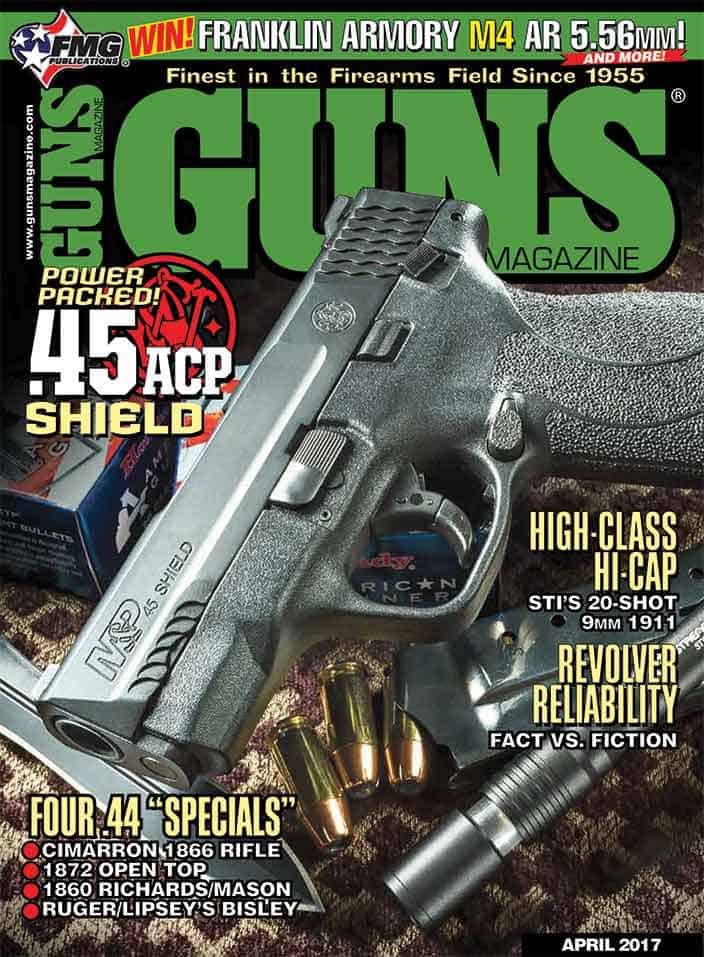"Game-Good"
Is Your Rifle Adequately Accurate For The Hunt?
When I started big game hunting in Montana in the 1960’s, many hunters didn’t sight-in their rifle before opening day, especially those who used iron sights—and quite a few still did back then. Instead they “tried” their rifle on some informal object, often an empty can balanced on top of a fencepost. More formal hunters paced off 50 or 100 steps and placed a cardboard box on the ground. Purists would tape a paper target to the box, but many just aimed at the middle, and usually shot one round. If it hit the can or box they’d go slay a deer or elk.
Iron-sighted hunting rifles may seem like ancient history, but the ’60s were a period of rapid change. Top 100 radio songs could be anything from Lawrence Welk to the Rolling Stones, and big-game rifles could be anything from open-sighted Winchester lever-actions to shiny Weatherby’s with variable scopes—though within another decade scoped bolt-actions became almost universal.
During this transition many hunters grew dissatisfied with their 100-yard groups, thanks in part to magazine articles on the increasingly popular target game of benchrest shooting. They started dinking with their rifles and handloads, and as a result many 21st-century deer hunters feel 1/2-inch groups are necessary for slaying whitetails. Yet their grandfathers killed deer every year with iron-sighted rifles barely able to group 3 inches at 100 yards—if their grandfathers ever chose to waste ammo shooting more than one round at a target.
So what level of rifle accuracy do hunters need? The obvious answer is whatever is required for sure hits. This depends considerably on the ammo, sights and range, but by definition big game animals are relatively large. Over the decades I’ve measured many as they lay on the ground. This may seem weird but my college major was biology, and knowing an animal’s size can also help when aiming a rifle. Or at least it did before laser rangefinders.
Size Effect
The smallest buck deer have been southwestern whitetails, whether the subspecies called Coues in Arizona and New Mexico, or bucks from South Texas. From the bottom of the brisket to the top of the shoulders, most mature bucks from this region have measured 13-14 inches, while the does have measured around a foot. While some animals classified as “big game” by hunting organizations are much smaller, such as collared peccaries (commonly called javelina) and African steenbok, I personally refuse to call any animal weighing much less than 100 pounds “big.” At the other end of the spectrum I’ve measured moose, eland and various kinds of buffalo with chests over 3 feet from top to bottom.
In big game hunting the most common shot placement is the chest, since it contains the largest vital organs—the heart and lungs. Since these normally take up about 2/3 of an animal’s visible depth, a little math indicates the vital zone of a typical South Texas whitetail doe is about 8 inches across, the diameter of an “official” volleyball. The accuracy required to hit a volleyball at 100 yards ain’t much, the reason our ancestors could consistently do it with buckhorn sights.
Or at least some of our ancestors could. There’s always been considerable variability in shooter ability, and since scope sights became almost universal, there’s also been considerable variability in what’s considered “hunting range.” As range increases, the probability of hitting a volleyball decreases, for several reasons aside from shooting skill.
Inherent Errors
First is the error inherent in the rifle and load. In theory, a rifle capable of putting all its shots into an inch at 100 yards should also put them into 6 inches at 600 yards, even smaller than “minute of volleyball.” But this strict arithmetical progression rarely works out in practice, due to several factors.
One is parallax in our scope. For an explanation of parallax see this month’s optics column, but here let’s just say there’s often some aiming error possible from typical hunting scopes much beyond 150 yards.
Another is wind. Unless we’re shooting in totally still air (difficult to find outdoors), bullets will drift some—and wind drift increases exponentially, not arithmetically. Instead of increasing at the same rate as range, it increases at about twice the rate—four times as much at double the range. As an example, let’s say a deer hunter is using one of today’s cutting-edge outfits, an accurate bolt-action in 6.5 Creedmoor pushing a 140-grain Berger Hunting VLD at a muzzle velocity of 2,750 fps.
Part of the reason for the increasing popularity of the Creedmoor is the minimal wind-drift of high ballistic-coefficient bullets like Bergers. In a 5-mph crosswind blowing at 90 degrees to the shooter, the VLD will drift 1.2 inches at 200 yards in “standard atmospheric conditions” (59 degrees Fahrenheit at sea level). At 400 yards it drifts 4.9 inches, slightly over four times as much—and a 5-mph wind isn’t very fast.
In fact, many deer hunters don’t believe 5 mph is enough to “move” a bullet, though even smaller changes in velocity and direction of air currents will open groups considerably at longer ranges. If the wind’s only 2 mph, the same 140-grain VLD will drift 2 inches at 400 yards. Many people consider a 1-mph breeze “dead calm,” but if it switches 180 degrees between shots, it also opens the group 2 inches at 400. Increase the range to 600 yards and a 5-mph wind drifts the same bullet almost a foot, and a full switch of a 1-mph breeze will open a group almost 5 inches.
Unstable?
Many shooters believe this relative widening of groups at longer ranges is due to bullets “destabilizing” as they slow down, but in reality spinning bullets become more stable as their velocity slows—as long as they remain above the speed of sound, a little over 1,100 fps at sea level. Very few spitzers from modern big game cartridges slow to the speed of sound at much less than 1,000 yards.
Yet another factor is the number of rounds in a group. Today almost all hunters shoot 3-shot groups, because 3 is the minimum you can call a “group” (two’s a pair), and 3 shots have the best chance of landing in a tiny cluster they can brag up to their buddies. Unfortunately, 3-shot groups do not reflect the maximum possible spread of shots from a given rifle/ammo/scope combination.
Longtime gunwriter Jim Carmichel once noted the “pet load” of many deer rifles is chosen by a single 3-round group, shot when a hunter goes to the range with several handloads using powder charges varying a grain. One group ends up smaller than the others, so gets picked as the rifle’s most accurate handload. In reality, the odds of repeating the same group with the same load are almost as low as a single-pull payoff on a Vegas slot machine. Instead the small cluster happened due to chance, due to the minimal number of shots.
The same hunter often believes some of his other groups contain “fliers,” shots landing a little ways from the other two due to a faulty trigger pull, or a bullet hitting a horsefly on its way to the target. It could be a bad trigger pull, or maybe even a fly, but when two shots from a 3-shot group land close together, with the third a little ways away, it’s normally an example of the rifle’s actual level of accuracy. If the shooter puts three more rounds into a 3-shot group with a “flier,” the group normally doesn’t open up much, and often not at all, because a 6-round group is statistically closer to the rifle’s actual accuracy level. (In fact, one professional statistician who’s also an enthusiastic shooter believes 6-shot groups are the most statistically sensible for testing rifles and ammo. But he also recognizes most shooters aren’t going to shoot 6-shot groups.)
All these factors result in several seemingly contradictory attitudes among big game hunters—or more properly, broad groups of big game hunters. And despite the contradictions, all of them are correct.
The first group would be the few remaining members of the practical iron-sighted hunters I knew as a kid. They only put one round into a yearly target because their rifle had long ago proven accurate enough to hit a volleyball at any range practical for iron sights. They didn’t care about 1-inch groups at 100 yards. Instead they cared about putting one shot in a volleyball—or in the case of a bull elk, a beach ball.
The second group probably represents three-quarters of today’s big game hunters, and in North America “big game” usually means white-tailed deer. They use scopes, the vast majority 3-9X or 3-10X variables without any means of correcting parallax. They shoot factory ammo rather than handloads, and if three rounds group into less than 2 inches at 100 yards during “sight-in day” at the local range, they’re content. These hunters normally sit somewhere rather than go looking for deer, partly because so many whitetails infest much of North America, and partly because most hunt relatively small parcels of land, where due to vegetation or terrain they can’t see beyond 250 yards, much less shoot any farther. While sitting, they usually arrange some sort of rest for their rifle, and 2-inch, 3-shot groups at 100 yards will definitely hit a volleyball out to 250 yards.
The third group is more serious about their hunting and shooting. They handload their ammunition, and usually insist on 1-inch, 3-shot groups at 100 yards. They often hunt game other than whitetails, whether pronghorn, mule deer, caribou, elk or moose in North America, or “plains game” in Africa. All are at least the size of Southwestern whitetails, with some much larger, and these hunters will take longer shots than the average factory-ammo deer hunter, though normally not over 400 yards.
This is the group most often offended by the notion of 3-shot groups being insufficient proof of accuracy, partly because they read more about shooting than most factory-ammo hunters, so encounter more “offensive” ideas. But they’re also right because, once again, big game animals are by definition big, and 1-inch, 3-shot groups at 100 yards are more than sufficient to hit a volleyball at 400 yards, even if the groups don’t demonstrate the absolute potential of a rifle and load. In fact, I’ve taken a number of big game animals from 350 to 450 yards away using rifles and ammo that won’t average smaller than 1-1/2 inches for 3-shot groups at 100 yards. Yet many hunters obsess over working up 1/2-inch handloads, apparently because of buddies who brag about their 1/2-inch rifles.
The last group is often called “long-range hunters,” who shoot big game beyond 400 yards. Strictly speaking, I’ve been one for almost 30 years, starting long before laser range-finders appeared on the civilian market. Instead I compared my scope’s reticle to the animal’s body size (one reason I measured so many), providing a much closer estimate of range than “guesstimating.”
Today, however, lasers make longer shots far easier. Many hunters shoot groups at ranges out to 600 yards or more, but more often on steel plates than on paper targets, because it takes too darn long to travel back and forth when checking paper. And some don’t even shoot groups, instead figuring if they can hit a 6-inch gong consistently at 600 yards, they can also hit a volleyball every time. They may work up their handloads at 100 yards, but the real information comes from shooting at longer ranges.
Please note I’m not putting down any of these groups, because I belong to all four. I try to hunt some with iron sights every year, and while I don’t always succeed, it’s always a lot of fun, and far more effective than most scope-sight-only hunters imagine. In 2003, for example, I went on an African safari with two rifles, one with an aperture sight and the other with “express” sights, and took six big game animals with 10 shots at ranges out to 225 yards. One of the extra shots was a clean miss, caused by a herd of nosy giraffes spooking the impala I was aiming at. The other three went into a Cape buffalo, the last an “insurance shot” after the bull was down, but either of the first two would have been fatal.
At the other extreme, I may not shoot any big game beyond 400 yards in any year, but will shoot some varmints, usually with at least one of my big game rifles. I used to shoot prairie dogs quite a bit out to half a mile or more, but these days limit myself to shots with a high chance of succeeding on the first try, and 500 to 600 yards is a far more realistic limit.
But no matter the method used, all my hunting rifles have actually been tested at the maximum range where they might be used, to make sure they’re capable of consistently hitting a volleyball, because this is far more important than the size of 100-yard groups, no matter how much we brag about them.












